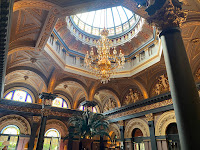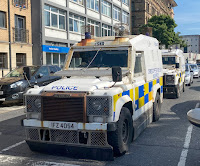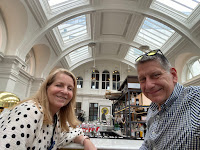Derry (known in Britain as Londonderry) is an incredibly historic town, fought over since Viking times. The walls around the city, completed by the English Protestants around 1618, are intact and provide a great way to literally walk “around” the city and learn about its history. The region is predominantly Catholic, so the walls kept the Protestants in and the Catholics out. The city is famous for repulsing the Catholic army of deposed King James I in 1688. The city is equally famous for the Bloody Sunday massacre in 1972 that triggered the Troubles (and the U2 song).
 |
| Derry Diamond |
 |
| Derry Wall canon |
 |
| St Augustine Chapel |
 |
| Columb Cathedral |
 |
| Guild Hall from Derry wall |
 |
| Bishop's Gate |
The Guildhall, just outside the walls, is a beautiful building and has a small museum dedicated to the “Plantations of Ulster”. It describes Britain’s intentional settlement of mostly Scottish farmers into the land confiscated in Ulster from Catholics who fought against the English in the early seventeenth century.
 |
| Waterloo Street |
Waterloo street, just outside the walls at Butcher Gate, has numerous pubs that we visited. Peader O’Donnell’s pub had good live music. We had a great meal at Exchange Restaurant and Wine Bar near the Peace Bridge. Dinner at Fitzroy’s was very good.
 |
| |
We took a walking tour of the various murals that adorn buildings throughout the Bogside neighborhood, the site of most of the protests, riots and violence of the Troubles in Derry. The Free Derry Museum is fantastic, and the best museum we visited in Ireland. It chronicles the events leading up to Bloody Sunday, and should not be missed. The related Peacemakers Museum follows the history of the Troubles after Bloody Sunday, through the Good Friday accord in 1998 that ended the Troubles, but was not as compelling as the Free Derry Museum. Both museums provide the Catholic viewpoint, the Protestant viewpoint is evident within the walls of the city. Since the 1970s, the Catholic Irish have found common cause with Palestinians, and it is evident in Bogside with many Palestinian flags and signs.  |
| Palestinian mural |
 |
| Bloody Sunday |
 |
| The Innocents |
 |
| Operation Motorman |
 |
| Operation Motorman |
 |
| The Hunger Strikers |
 |
H-Block Memorial,
where Republican prisoner
were held |
 |
Memorial on the spot of the
first shots of Blood Sunday |
 |
| The Oppressed |
Portrush is a seaside community that is often the jumping-off point for visits to Giant’s causeway, which we visited several years ago. There’s not much to the town, but the 2025 British Open is being played at the Royal Portrush. We visited the clubhouse and saw a few of the holes.
The Harbour Bistro bar is tiny, but is the unofficial home of Irish golfer Darren Clarke (he keeps his 2011 British Open trophy in a case at the bar). The bartender Alex was great, we spoke to him for over an hour. We had a great dinner at Shanty, which has amazing views from their deck over the water, from which you can see Royal Portrush golf course. The Elephant Rock B&B was excellent, with beautiful views of the sea.
Outside of town, just east of Royal Portrush, are the ruins of Dunluce Castle. Dating from the Middle Ages, in 1639 the dining room of the castle collapsed into the sea, forcing the Countess of Antrim to abandon the castle.
 |
| View of Royal Portrush |
 |
| British Open at Royal Portrush |
 |
| Dunluce Castle |
Belfast
On our first visit to Belfast, we took a guided “Troubles Tour” which walked through the Protestant Shankill Road and Catholic Falls Road. It was a fantastic overview of the Troubles, providing insights from a local resident who lived through those difficult times. On this trip, we focused on other areas of the city.
The neighborhood around Queens University (where our hotel was located) is really nice, with lots of shops and restaurants; the university is beautiful. In City Center, there is lots of Victorian architecture, since Belfast was a booming manufacturing city for the UK during the industrial revolution. The Crown Liquor saloon is typical of Victorian pubs, with “snugs” which are discrete little cubicles where couples can drink without being seen (there are several of these Victorian bars in Dublin as well). Across the street, the contemporary Europa Hotel was bombed over 30 times during the Troubles! Bill Clinton stayed here during the negotiations of the Good Friday accord. The Linen Hall Library has displays of political posters that are very interesting.
 |
| Queens University |
 |
| Belfast City Hall |
 |
| Belfast Opera House |
Cathedral Quarter has a maze of streets that are filled with pubs. Merchant Hotel was previously a bank, and has a stunning interior. Whites Tavern is the oldest in Belfast, the Duke of York is where journalists met during Troubles. Kelley's Cellar was the site of the 1798 Rising planning (we had dinner at Mourne’s next door), and The Sunflower has a cage at its entrance where guests would be screened prior to entry during the Troubles (after a spate of bar shootings by both Loyalists and IRA); it’s a grim reminder of those violent times. The Northern Ireland War Memorial is very small but has an interesting display of memorabilia.
 |
| Belfast Cathedral |
 |
| Exchange Place |
 |
| Duke of York |
 |
| Sunflower Bar cage |
 |
| Merchants Hotel lobby |
 |
| Protestant mural |
 |
| Protestant poster |
 |
"Crimestoppers Anonymous" -
whatever that means... |
 |
| Northern Ireland War Memorial |
 |
| White's tavern |
The Titanic Quarter comprises the former H&W Shipyard that built the Titanic and hundreds of other ships, as Belfast was the major shipbuilding site in the UK. The Titanic Museum was very interesting and well curated. The Titanic Hotel is in the old headquarters building of H&W, and the old drafting room has been converted into a beautiful bar.
 |
| Titanic "listing test" |
 |
| Titanic Hotel Bar |
 |
| Actual deckchair from Titanic |
On the drive from Belfast to Dublin we visited Monasterboice, a former abbey from the Middle Ages. Amid the ruins are numerous ancient Celtic Cross grave markers, with the Cross of Murdock (c. 923) considered the finest in Ireland; the intricate carvings are noteworthy. We then visited several sites along the River Boyne. There is a small museum at the site of the Battle of the Boyne, where in 1690 British forces under King William III defeated Catholic resistance forces under deposed King James I (supported by the Dutch), securing control of Ireland for Britain. We visited Newgrange which is a Neolithic Age (3200 BC) burial mound. Finally, in the small town of Trim are the incredible ruins of Trim Castle overlooking the Rover Boyne.
 |
| Trim Castle |
 |
| Monasterboice round tower |
 |
| Cross of Murdock |








































No comments:
Post a Comment